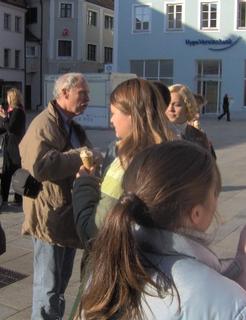Jewish Archeology
 This afternoon on our tour of the Jewish archeological site at Neupfarrplatz we were joined by Professor of Marketing Fred Miller who chairs Regensburg Programs Committee.
This afternoon on our tour of the Jewish archeological site at Neupfarrplatz we were joined by Professor of Marketing Fred Miller who chairs Regensburg Programs Committee.
The excavations that uncovered the foundations of the Romanesque and Gothic synagogues were carried out from 1995-1998 within what was the Jewish section of Regensburg—said to be Germany’s oldest Jewish community.

The dig also uncovered cellars of the houses of merchants whose long distance trade with the Near East made theirs one of the most prosperous Jewish communities in Europe. Proof of that prosperity was the discovery of a large cache of gold coins and a gold ring thought to have belonged to a synagogue official.

Also of interest was a small bronze figure of a high priest of the 15th century identified as Aharon.

Throughout the Middle Age, the Jewish community enjoyed imperial protection but in 1519, as Martin Luther launched his reformation and Charles, a Hapsburg of Spain which had expelled its Jews became Holy Roman Emperor that protection came to an end. The Jewish community was burned to the ground and Jewish gravestones taken and used elsewhere as buildingstone. On the site of the synagogue a Catholic church was raised which, in short order, became a Protestant Church as Regensburg moved into Luther’s camp.

The excavations also turned up remains of the Roman outpost of Castra Regina, founded by the Emperor Marcus Aurelius in 179 CE. One artifact found at that level was a figure of Mercury, not unlike the much later figure of Aharon.

Now the site of a large kaufhaus (department store), banks, and specialty shops, Neupfarrplatz has seen a number of historic events including a 1919 Communist rally of workers and soldiers inspired by Rosa Luxemburg’s Spartakis movement that swept Regensburg and the rest of Bavaria into a short-lived Bavarian Soviet Republic (Räterepublik Baiern). In 1933 Nazis chose Neupfarrplatz as the site of their Regensburg book burning, one of hundreds that took place in a single night throughout Germany. During WWII anti-Hitler demonstrators gathered there only to be crushed by Nazi troops.

Today Regensburg again has a thriving Jewish community and its relations with Christians are generally good. Yet the city fathers of Regensburg, the home town of Pope Benedict XVI, had to be prodded to acknowledge the city’s past anti-Semitism. When Jewish activists called for a historical marker explaining the 650-year-old anti-Semitic sculpture of the Judensau (Jewish sow) on the side of the Dom (St. Peter’s Cathedral) that defames Jews by showing them sucking at a sow's teats, city official refused. Finally, a little over a year ago, compromised was reached and a plaque put up calling attention to the Judensau.


This spring Regensburg was visited by U.S. Special Envoy for Holocaust Issues Edward B. O’Donnell who met with Rabbi Dannyel Morag and other prominent members of the Jewish community. Later some 300 people attended his lecture at the university on the need for German-American cooperation to fight against anti-Semitism and for freedom, democracy, tolerance and global human rights.

Oh yes—the plague (a marvel of historical vagary) reads (in German only): "Nowadays, the relationship between Christians and Jews is one of tolerance and respect."
Good to know.

1 Comments:
Is there any way to take the virtual tour....ahem...virtually? I am researching the ritual murder accusations against the Jewish community of Regensburg in the 1470's, and I'm trying to get a sense of what the Jewish quarter looked like. Any idea?
Post a Comment
<< Home